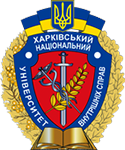Police crime in 1947 in the coverage of the Ukrainian SSR state security agencies
Abstract
One of the least researched issues in historical and legal science, such as crime in one of the main law enforcement agencies of police, which operated on the territory of the Ukrainian SSR, has been covered. Instead of counteracting, some police officers organized crimes and participated in them personally. The involvement of police officers in various criminal and official crimes has been revealed: treason during the Soviet-German war, robbery, bribery, extortion, assistance to criminals, official negligence. Materials collected by the employees of the Ministry of State Security regarding some negative aspects of the police officers activities during 1947 testify to significant abuses and violations of the law. It has been established that a certain part of the policemen were traitors during the war, worked with the occupation authorities and took part in repressions against members of the Resistance movement and ordinary people. This problem was acute at that time, because only 2 years had passed since the end of the war, and the state security authorities continued to work on identifying and detaining these persons, who were also among the police officers.
The problem of bribery in the police is the second in number of facts. It was widespread, as in the previous periods, among the employees of passport offices, traffic police, district police officers, who collected “tribute” from traders in the markets, having established a certain system of extortion, prices and appointed “senior” to collect bribes. There were even more odious cases when a whole group of policemen engaged in robbery, taking products and things from local villagers, while trying to disguise themselves as Banderites (copying the work methods of the KGB agents). Drunkenness was also quite common among police officers, which led to abuse, merging with criminal elements, and connivance with lawbreakers.
It has been emphasized that that was not the main aspect of the police activity that time. The majority of police officers faithfully fulfilled their duty to protect the law and combat crime. The stated facts are based on the materials of the Branch State Archive of the Security Service of Ukraine, which have not been published before. Most of the given materials concern Kyiv, obviously, the capital’s KGB agents worked better than their colleagues from the periphery. Also, the document quite often does not indicate what measures were applied to the specified violators of the law and what was their further fate.
Downloads
References
Bandurka, O. M. (2015). Millennium of crime in Ukraine. Golden Mile.
Bandurka, O. M. (2022). From general secretaries to Ministers of Internal Affairs. Maidan.
Bilas, I. H. (1994). Repressive and punitive system in Ukraine. 1917–1953: Socio-political and historical-legal analysis (book 1). Lybid; Army of Ukraine.
Bortnik, O. M., & Grechenko, V. A. (2019). Organization and activity of militia in the Ukrainian SSR in 1947: basic aspects. Legal Horizons, 17(30), 7-13. https://doi.org/10.21272/legalhorizons.2019.i17.p7.
Brusakova, O. V., & Grechenko, V. A. (2022). Combating crime in the first years after the Second World War (1946–1948). In International Science Group, Scientific Foundations of State and Law (pp. 147-164). Primedia Launch.
Brusakova, O. V., & Hrechenko, V. A. (2022). Legal foundations of the organization and activity of the Ukrainian SSR police in 1949-1950s. Law and Safety, 2(85), 121-130. https://doi.org/10.32631/pb.2022.2.11.
Grechenko, V. A. (2022, April 20). Counteraction to lawlessness in the militia of the Ukrainian SSR in the first post-war year [Conference presentation abstract]. Scientific and Practical Conference “Problems of modern polytheistics”, Kharkiv, Ukraine.
Grechenko, V. A. (Ed.). (2021). Leaders of the Kharkiv militia / police (1918–2021): historical and legal research. Maidan.
Herus, M. M. (2021). Criminal justice in the Ukrainian SSR in the post-war period (1945–1958): historical and legal research [Doctoral dissertation, National Academy of Internal Affairs].
Lahosha, M. M. (2000). Militia of Ukraine in 1945–1953 [Candidate thesis, Donetsk State University].
Okipniuk, V. T. (2019). Soviet state security agencies in Ukraine during teeing of the totalitarian regime (1929–1953). OLDI-PLUS.
Prystaiko, O. V. (2021). NKVD-MIA of the Ukrainian SSR (1934–1954): structural construction and functions (historical and legal research) [Doctoral dissertation, National Academy of Internal Affairs].
Shapoval, Yu. I. (1990). L. M. Kahanovych in Ukraine. Ukrainian Historical Journal, 3, 47-59.
Veselova, O. M. (2006). Famine 1946-47. In I. M. Dziuba, A. I. Zhukovskyi, M. H. Zhelezniak et al., Encyclopedia of modern Ukraine (Vol. 6). IED NAN Ukrainy.
Voitsekhovskyi, M. M. (2001). Legal foundations of the organization andactivity of the militia of Ukraine in the post-war period (1946–1953) [Candidate dissertation, Kharkiv National University of Internal Affairs].
Yarmysh, O. N., & Grechenko, V. A. (2021). Official crimes in the militia in 1937 and counteraction to them. Historical and Legal Journal, 2(17), 33-41. https://doi.org/10.32782/2409-4544/2021-2/5.
Yarmysh, O. N., & Grechenko, V. A. (2022). Crime in the militia of the USSR in the mid-1930s: main aspects. Science and Law Enforcement, 1(55), 37-52.
Copyright (c) 2022 O. N. Yarmysh, V. A. Grechenko

This work is licensed under a Creative Commons Attribution 4.0 International License.



